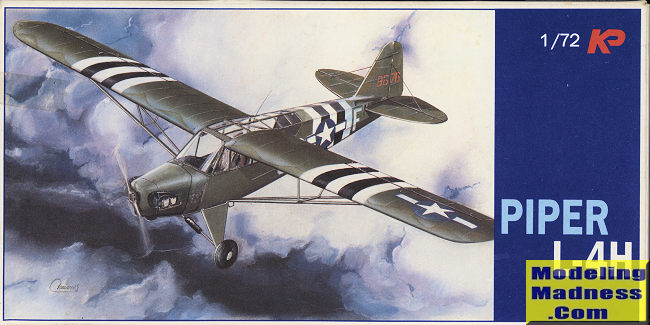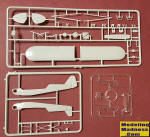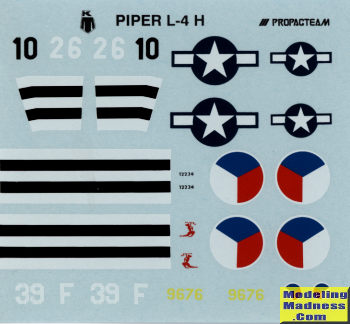
KP 1/72 Piper L-4H Cub
| KIT #: | KP 033 |
| PRICE: | $10 on the used kit market |
| DECALS: | Three options |
| REVIEWER: | Scott Van Aken |
| NOTES: | Initial tooling from 1992 |

| HISTORY |
The Piper J-3 Cub is an American light aircraft that was built between 1937 and 1947 by Piper Aircraft. The aircraft has a simple, lightweight design which gives it good low-speed handling properties and short-field performance. The Cub is one of the best known light aircraft of all time. Its simplicity, affordability and popularity — as well as large production numbers with nearly 20,000 built in the United States — invokes comparisons to the Ford Model T automobile.
The Aircraft is a high-wing, strut-braced monoplane with a large-area rectangular wing. It is powered by an air-cooled piston engine driving a fixed-pitch propeller. Its fuselage is a welded steel frame covered in fabric, seating two people in tandem.
The Cub was originally intended as a trainer and had great popularity in this role and as a general aviation aircraft. Due to its performance, it was well suited for a variety of military uses such as reconnaissance, liaison and ground control. It was produced in large numbers during World War II as the L-4 Grasshopper. Many Cubs are still flying today. Notably, Cubs are highly prized as bush aircraft.
The aircraft's standard chrome yellow paint has come to be known as "Cub Yellow" or "Lock Haven Yellow".
The L-4 Grasshopper was mechanically identical to the J-3 civilian Cub, but was distinguishable by the use of a Plexiglas greenhouse skylight and rear windows for improved visibility, much like the Taylorcraft L-2 and Aeronca L-3 also in use with the US armed forces. Carrying a single pilot and no passenger, the L-4 had a top speed of 85 mph (137 km/h), a cruise speed of 75 mph (121 km/h), a service ceiling of 12,000 ft (3,658 m), a stall speed of 38 mph (61 km/h), an endurance of three hours, and a range of 225 mi (362 km). Some 5,413 L-4s were produced for U.S. forces, including 250 built for the U.S. Navy under contract as the NE-1 and NE-2.[
| THE KIT |
 Scalemates
states that this kit came out in 1992 and while it seems older than that, I'll
go with that for the meantime. The kit is typical of their other earlier kits
with raised panel lines, nice detailing, somewhat crude detail parts, a bit of
flash and some rather thick mold seams. Since the kit has lots of rather thin
parts, I can anticipate many of these breaking upon removal from the sprues or
during clean-up as KP plastic tends to be a tad brittle.
Scalemates
states that this kit came out in 1992 and while it seems older than that, I'll
go with that for the meantime. The kit is typical of their other earlier kits
with raised panel lines, nice detailing, somewhat crude detail parts, a bit of
flash and some rather thick mold seams. Since the kit has lots of rather thin
parts, I can anticipate many of these breaking upon removal from the sprues or
during clean-up as KP plastic tends to be a tad brittle.
Two grey sprues and one clear don't take up a lot of room in a fairly small box. The actual construction seems pretty straight forward, though there are small parts. No interior sidewall detail, though there is the very prominent upper interior framework provided. The back seat is little more than a pad on the floor with a strap for a seat back.
The kit does provide an engine as
the cylinders stick out into the wind, but it is little more than a generic
representation of an engine so if you want something with detail it is time to
search for a resin replacement or scratchbuild the cylinders. Fortunately, most
of it will be hidden under a heat shield. I would suggest building up the
fuselage with the already masked windows, then painting it before attaching the
already painted wings as getting in there
 through the
struts to mask will be a real pain. Fortunately the wing is a single piece with
a spar so getting it to fit should not be much of an issue. I am sure that the
landing gear will be a tad fragile when assembling, but once done should be
sturdy enough.
through the
struts to mask will be a real pain. Fortunately the wing is a single piece with
a spar so getting it to fit should not be much of an issue. I am sure that the
landing gear will be a tad fragile when assembling, but once done should be
sturdy enough.
KP instructions are always great with superb detail drawings. Humbrol, generic, and FS 595 color references are provided. There are three markings options. The box art plane is a post D-day version and you are provided two Czech versions. One in an overall greenish shade and numbered 26. The other is numbered 10 in silver dope. Decals are nicely done, though I expect the yellow ones to disappear upon application as these older KP kit decals did not back up red and yellow with white. It isn't an issue as I'll be using aftermarket on them anyway.
| CONCLUSIONS |
Richard F built a floatplane version of this a few years back and I'll be using that one as a guide when this gets startsd. There is also a 2015 new tool kit out there so if you don't want to deal with what is essentially a short run kit, I would recommend looking for that one.
| REFERENCES |
https://en.wikipedia.org/wiki/Piper_J-3_Cub
January 2018
Copyright ModelingMadness.com. All rights reserved.
If you would like your product reviewed fairly and fairly quickly, please contact the editor or see other details in the Note to Contributors.
Back to the Main Page Back to the Review Index Page Back to the Previews Index Page